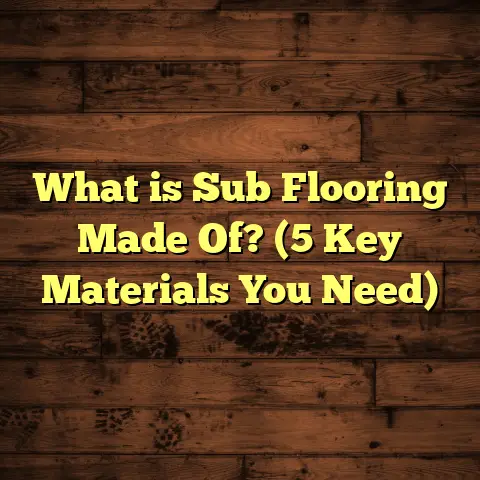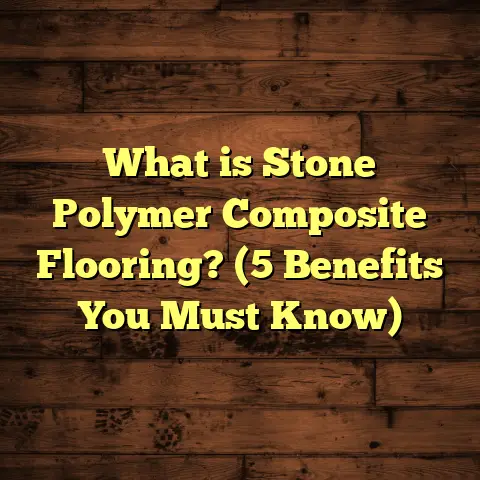What is Quartzite Flooring? (5 Benefits for Your Home)
Quartzite flooring—that’s a name that might not pop up as often as hardwood or tile when people talk about flooring options. But trust me, once you get to know quartzite, it’s hard to ignore its charm. I remember the first time I laid eyes on a quartzite slab; it was like discovering a hidden gem. The stone’s natural crystalline shine combined with rugged durability made it stand out in a way synthetic materials just can’t match.
Over the years, I’ve worked on dozens of flooring projects involving quartzite—and each one has been a learning experience. What I want to do here is share everything I’ve picked up: what quartzite flooring really is, why it’s worth considering for your home, how it compares to other stones, and some practical advice to help you decide if it’s right for you.
What is Quartzite Flooring?
When you hear “quartzite,” you might immediately think of quartz countertops or maybe confuse it with quartz. But quartzite is a natural metamorphic rock formed when sandstone undergoes intense heat and pressure deep beneath the earth’s surface. This process fuses the quartz grains tightly together, creating an incredibly dense and durable stone.
So, quartzite flooring means using slabs or tiles cut from this natural stone to cover your floors. These tiles are then polished or finished in a way that highlights their unique patterns and colors.
Unlike other stones such as marble or limestone, quartzite is much harder—about 7 on the Mohs hardness scale (marble scores around 3-4). This makes quartzite particularly resistant to scratches and everyday wear.
Here’s something I noticed early on: every slab of quartzite feels like it has its own personality. The color ranges from soft whites and beiges to grays, blues, and even pinkish tones. The veining varies too—sometimes subtle, sometimes bold. This uniqueness can give your space a natural yet sophisticated look.
Quartzite floors aren’t just beautiful; they’re practical too. The stone’s density makes it naturally resistant to stains and heat (more on this later). When sealed properly, quartzite flooring can be easy to maintain while lasting for decades.
How Quartzite Flooring Fits into Your Home
I’ve installed quartzite floors in kitchens, living rooms, hallways, and even bathrooms. One of the things homeowners ask me most often is whether quartzite suits their lifestyle.
Here’s the thing: quartzite is a fantastic choice if you want flooring that can handle heavy foot traffic without losing its appeal. Families with kids or pets will appreciate how hard quartzite is—it doesn’t scratch easily like softer stones or wood floors.
In kitchens, where spills happen frequently, quartzite’s stain resistance comes in handy. And if you’re someone who enjoys cooking with hot pans or placing hot dishes on the counter, quartzite won’t disappoint. It tolerates heat better than many other natural stones.
I also find quartzite works well in modern and traditional homes alike. Its natural texture pairs beautifully with rustic décor but can also complement sleek, contemporary designs.
Five Benefits of Quartzite Flooring for Your Home
Let me walk you through five major reasons I recommend quartzite flooring to homeowners who want something both practical and visually striking.
1. Exceptional Durability That Stands the Test of Time
Durability is often the first thing I consider when suggesting flooring options. Quartzite is one of the hardest natural stones available—ranking about 7 out of 10 on the Mohs hardness scale. To put that in perspective, granite also scores around 6-7, while marble sits much lower at 3-4.
This means quartzite resists scratches from shoes, furniture movement, and even pets’ claws much better than marble or softer stones.
A study by the Natural Stone Institute showed that quartzite floors installed in commercial settings still looked great after many years of heavy foot traffic. Residential homes can expect similar longevity with proper care.
I once worked on a large family home where the quartzite tile floor had been installed nearly 20 years prior. Despite being in a high-traffic area near the kitchen and entryway, the floor showed minimal signs of wear. That’s durability that pays off over time.
2. Heat and Stain Resistance for Practical Living
Anyone who’s spilled red wine or accidentally left a hot pan on the floor knows how flooring can take a beating in everyday life.
Quartzite is naturally resistant to heat—something I learned firsthand during a kitchen renovation. The homeowner frequently used cast iron pans and placed hot pots directly on the floor while cooking. Quartzite stood up without cracking or discoloring.
The stone’s dense structure also means it doesn’t absorb liquids easily when sealed correctly. While no stone is 100% stain-proof, quartzite performs very well against stains from coffee, wine, and oils compared to marble or limestone.
3. Unique Appearance Adds Character to Your Space
Quartzite offers something special: no two slabs are identical. Each tile has its own veining pattern and color variations created by nature over millions of years.
I recall a client who wanted a soft gray floor with subtle pink hues for their living room. We sourced quartzite that perfectly matched this palette. The final look was elegant but far from ordinary—something you just don’t get with manufactured flooring materials.
This uniqueness means your floor becomes a piece of art—not just a functional surface underfoot.
4. Easy Maintenance Keeps Life Simple
Life gets busy—I get that. That’s why I appreciate quartzite’s relatively low maintenance needs.
Daily cleaning involves sweeping or vacuuming to remove dirt and grit that can scratch any floor surface. Mopping with a pH-neutral cleaner keeps the tiles looking fresh without damaging the stone or sealant.
Re-sealing every 1-2 years prevents staining and protects against moisture intrusion. It’s a simple process that can be done by professionals or handy homeowners themselves.
With kids running around and pets shedding hair constantly in my own home, having a floor that cleans up easily was a huge relief.
5. Adds Value When Reselling Your Home
Investing in flooring isn’t just about comfort—it’s also about enhancing your home’s resale value.
According to Remodeling Magazine’s Cost vs Value report, natural stone flooring returns around 80% of its cost upon resale on average. Quartzite’s rarity compared to granite or marble makes it a distinctive selling point for potential buyers.
I’ve seen homes with quartzite floors attract more attention during showings simply because the floors stand out as premium features.
How Quartzite Compares to Other Popular Stones
If you’re weighing options like granite, marble, or even engineered stone, here’s how quartzite stacks up:
| Feature | Quartzite | Granite | Marble | Engineered Stone |
|---|---|---|---|---|
| Hardness (Mohs) | ~7 | 6-7 | 3-4 | ~7 (varies) |
| Stain Resistance | High (with sealing) | High | Low | High |
| Heat Resistance | Very good | Very good | Moderate | Moderate-High |
| Maintenance | Low | Low | Moderate | Low |
| Unique Patterns | Yes (natural veining) | Speckled/granular | Swirled/veined | Consistent/Varied |
| Cost Range | $$$ | $$-$$$ | $$-$$$ | $$-$$$ |
Granite is hard but often has more speckled appearances; marble offers elegance but lacks durability; engineered stone (quartz composites) provide uniform looks but lack true natural stone uniqueness.
Quartzite hits a sweet spot if you want natural beauty combined with toughness.
Real-Life Project Insights: A Case Study
Let me share a case study from one of my recent projects involving quartzite installation in a family home.
The homeowners wanted a floor that could withstand kids’ playtime chaos while giving their open-concept living area a polished look. After evaluating options, we went with white-gray quartzite slabs featuring soft blue veins.
Using FloorTally helped me estimate all costs upfront—from material sourcing to labor charges and waste factors—making budgeting straightforward.
Installation took about a week with professional stone masons carefully cutting and sealing each tile. After completion, the homeowners reported:
- No visible scratches after six months despite heavy foot traffic
- Minimal cleaning effort required
- Compliments from guests impressed by the unique floor patterns
- Increased interest from buyers when they later listed their home
This project reinforced my belief that quartzite provides long-term value beyond just aesthetics.
Installation Tips You Should Know
If you’re thinking about installing quartzite flooring yourself or hiring professionals, these tips might save time and money:
Choose Experienced Installers
Quartzite is dense and heavy; improper handling or cutting can cause cracks or chips. Working with installers who have experience with stone floors ensures good results.
Prepare Your Subfloor Thoroughly
The subfloor should be clean, level, and free of debris before installation starts. Uneven subfloors lead to tiles cracking down the line.
Use Proper Adhesives
Not all adhesives work well with natural stone—consult experts for recommended bonding materials suitable for quartzite tiles.
Seal Immediately After Installation
Sealing locks in moisture resistance and prevents staining. Don’t skip this step even if your installer assures you otherwise.
Pick Grout Color Carefully
Grout color impacts overall look—lighter grout brightens rooms but shows dirt easily; darker grout hides stains better but might darken the visual effect.
Allow for Expansion Joints
Natural stone expands/contracts slightly due to temperature changes; proper spacing prevents cracking.
Maintaining Quartzite Floors: Tips from My Experience
Keeping your quartzite floors looking great doesn’t require complex routines but sticking to basics helps immensely:
- Sweep or vacuum daily to prevent grit buildup that wears down surfaces
- Mop weekly using pH-neutral cleaners (avoid acidic or abrasive products)
- Wipe up spills immediately even though quartzite resists stains better than many stones
- Reseal every 12-24 months depending on foot traffic and wear
- Use floor protectors under furniture legs to avoid scratching
I recall one client who neglected resealing for several years—the floor absorbed oils from cooking spills, causing slight discoloration spots that had to be professionally treated later.
Cost Breakdown: Planning Your Budget Smartly
One challenge I often face with clients is budgeting accurately for premium flooring like quartzite. Prices vary widely based on quality of stone, tile size, labor rates, and location.
Here’s an approximate breakdown:
| Item | Estimated Cost per Sq Ft |
|---|---|
| Quartzite Material | $10 – $20 |
| Installation Labor | $5 – $10 |
| Sealing & Finishing | $1 – $2 |
| Additional Prep Work | Variable |
Total costs usually range from $15 to $30 per square foot installed.
FloorTally has been invaluable in helping me input local labor rates and material prices, then calculate waste factors so I never order too much or too little material. This tool saves headaches and prevents costly overruns during projects.
Environmental Impact: Is Quartzite Eco-Friendly?
For those thinking about sustainability, natural stone like quartzite scores well because it requires minimal processing compared to engineered materials.
Quartzite mining does have environmental effects like any quarrying operation but choosing suppliers committed to responsible practices helps reduce impact.
Plus, natural stone lasts longer than many alternatives—fewer replacements mean less waste over time.
Frequently Asked Questions About Quartzite Flooring
Here are some common questions I get asked:
Q: Can quartzite be used outdoors?
A: Yes! Quartzite’s hardness and weather resistance make it suitable for patios and walkways too.
Q: How does quartzite handle moisture?
A: Sealed properly, quartzite resists moisture well but prolonged water exposure should be avoided to prevent sealant breakdown.
Q: Is quartzite slippery when wet?
A: Polished quartzite can be slippery; honed or textured finishes offer better traction for wet areas like bathrooms.
Q: How thick are typical quartzite tiles?
A: Most are between ½ inch to ¾ inch thick depending on application and supplier offerings.
Wrapping Up My Thoughts on Quartzite Flooring
Choosing floors isn’t just about looks; it’s about investing in something that fits your lifestyle while enhancing your home’s value over years of use. Quartzite flooring offers an excellent balance of strength, beauty, and practicality.
From my experience working with countless clients on various projects:
- Quartzite handles everyday life demands better than softer stones
- Its unique patterns bring warmth and character into spaces
- Maintenance routines are straightforward compared to other natural stones
- Proper budgeting tools like FloorTally make planning realistic
If you want floors that combine natural elegance with toughness, consider giving quartzite a closer look—it might just surprise you as it did me when I first started installing it years ago!
If you want detailed advice on sourcing quality slabs or estimating costs for your specific space using FloorTally or other tools, feel free to ask anytime!





